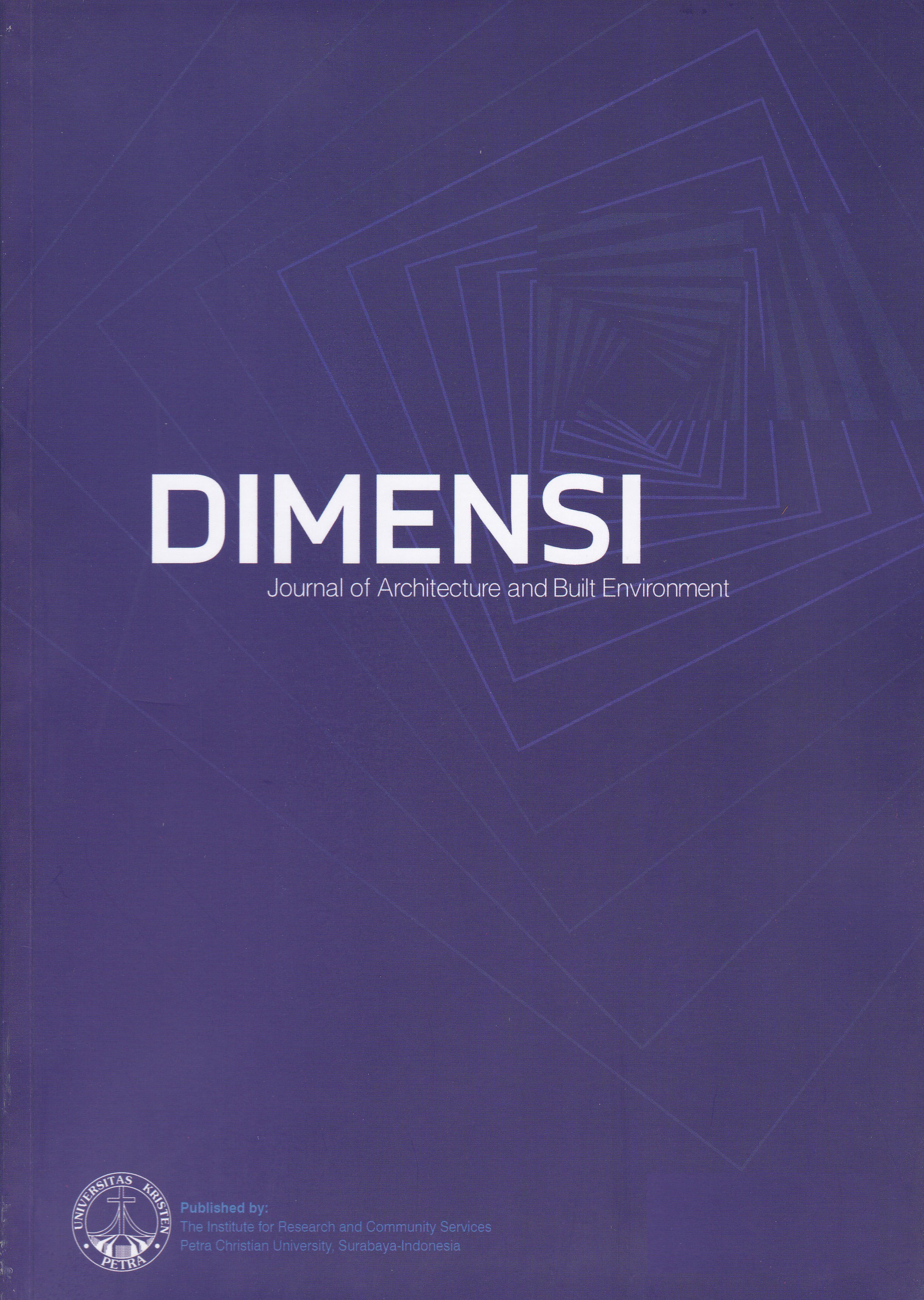PERFORMANCE OF BIOCLIMATIC ARCHITECTURE IN BUGIS VERNACULAR HOUSING: A CASE STUDY OF JIDA AND LAMMADA HOUSES
DOI:
https://doi.org/10.9744/dimensi.48.2.131-140Keywords:
Bioclimatic, Bugis vernacular housing, thermal environmental comfortAbstract
Bioclimatic architecture is composed of climate-responsive knowledge in vernacular buildings as an effort to create comfortable conditions. This study aims to evaluate the suitability of the application of bioclimatic design to the performance of the thermal environment in one type of Bugis house. The method used is visual assessment and measurement of temperature and humidity in the case studies of Jida and Lammada houses, South Sulawesi. The results of visual observations show the accuracy of the bioclimatic design on the volume and slope elements of the roof; wall type and material; floor height and shade tree layout. The performance of the thermal environment in the living room and bedroom of Lammada house is better than similar rooms at Jida house. The bioclimatic elements that affect the performance of the thermal environment are the volume of the roof, the type and material of the walls and the height of the floor.
Downloads
References
Abdullah, A. M., Aziz, A. A., Ahmad, A. S., & Mahdzar, S. S. S. (2013). Green technology: Comparison of thermal comfort levels for two traditional bugis houses in Malaysia. Advanced Science Letters, 19(12), 3512–3514. https://doi. org/10.1166/asl.2013.5208
Beccali, M., Strazzeri, V., Germanà, M. L., Melluso, V., & Galatioto, A. (2018). Vernacular and bioclimatic architecture and indoor thermal comfort implications in hot-humid climates: An over¬view. Renewable and Sustainable Energy Reviews, 82, 1726–1736. https://doi.org/10.1016/j.rser.2017.06.062
Daemei, A. B., Eghbali, S. R., & Khotbehsara, E. M. (2019). Bioclimatic design strategies: A guide¬line to enhance human thermal comfort in Cfa climate zones. Journal of Building Engineering, 25. https://doi.org/10.1016/j.jobe.2019.100758
Dili, A. S., Naseer, M. A., & Zacharia Varghese, T. (2011). Passive control methods for a comfor-table indoor environment: Comparative inves¬tiga-tion of traditional and modern architecture of Kerala in summer. Energy and Buildings, 43(2–3), 653–664. https://doi.org/10.1016/j.enbuild. 2010.11.006
Hildegardis, C., Agung Ayu Oka Saraswati, A., & Ketut Agusinta Dewi, N. (2019). Review of Thermal Comfort in Warm Humid Climate for Traditional Architecture in Indonesia. KnE Social Sciences, 2019, 151–166. https://doi.org/ 10.18502/kss.v3i21.4965
Manzano-Agugliaro, F., Montoya, F. G., Sabio-Ortega, A., & García-Cruz, A. (2015). Review of bioclimatic architecture strategies for achieving thermal comfort. Renewable and Sustainable Energy Reviews, 49, 736–755. https://doi.org/ 10.1016/j.rser.2015.04.095
Nguyen, A. T., Tran, Q. B., Tran, D. Q., & Reiter, S. (2011). An investigation on climate responsive design strategies of vernacular housing in Vietnam. Building and Environment, 46(10), 2088–2106. https://doi.org/10.1016/j.buildenv. 2011.04.019
Nguyen, A. T., Truong, N. S. H., Rockwood, D., & Tran Le, A. D. (2019). Studies on sustainable features of vernacular architecture in different regions across the world: A comprehensive syn-thesis and evaluation. Frontiers of Architectural Research, 8(4), 535–548. https://doi.org/10.1016 /j.foar.2019.07.006
Nugroho, A. M. (2012). A Thermal Assessment of the Traditional House In Flores , Indonesia. J. Basic. Appl. Sci. Res., 2(12), 12795–12801.
Nugroho, A. M. (2018). Arsitektur Tropis Nusantara: Rumah Tropis Nusantara Kontemporer. UB Press, Malang.
Nugroho, A. M. (2019). Rekayasa Ventilasi Alami Untuk Penyejukan Bangunan sebagai Wujud Kecerdasan Dasar Arsitektur Nusantara. UB Press, Malang.
Prasetyo, Y. H. (2016). Analisis Kinerja Termal dan Aerodinamis pada Rumah Tradisional Batak Toba Menggunakan Simulasi Digital dan Peng-ukuran Lapangan. Widyariset, 2(2), 131–142.
Prasetyo, Y. H., & Astuti, S. (2017). Ekspresi Bentuk Klimatik Tropis Arsitektur Tradisional Nusantara dalam Regionalisme. Jurnal Permukiman, 12(2), 80–93.
Victoria, J., Mahayuddin, S. A., Zaharuddin, W. A. Z. W., Harun, S. N., & Ismail, B. (2017). Bioclimatic Design Approach in Dayak Traditional Longhouse. Procedia Engineering, 180, 562–570. https://doi.org/10.1016/j.proeng.2017.04.215
Zune, M., Rodrigues, L., & Gillott, M. (2020). Vernacular passive design in Myanmar housing for thermal comfort. Sustainable Cities and Socie-ty, 54, 101992. https://doi.org/10.1016/j.scs. 2019.101992.
Downloads
Published
How to Cite
Issue
Section
License
Authors who publish with this journal agree to the following terms:
- Authors retain copyright and grant the journal right of first publication with the work simultaneously licensed under a Creative Commons Attribution License that allows others to share the work with an acknowledgement of the work's authorship and initial publication in this journal.
- Authors are able to enter into separate, additional contractual arrangements for the non-exclusive distribution of the journal's published version of the work (e.g., post it to an institutional repository or publish it in a book), with an acknowledgement of its initial publication in this journal.
- Authors are permitted and encouraged to post their work online (e.g., in institutional repositories or on their website) prior to and during the submission process, as it can lead to productive exchanges, as well as earlier and greater citation of published work (See The Effect of Open Access).



















